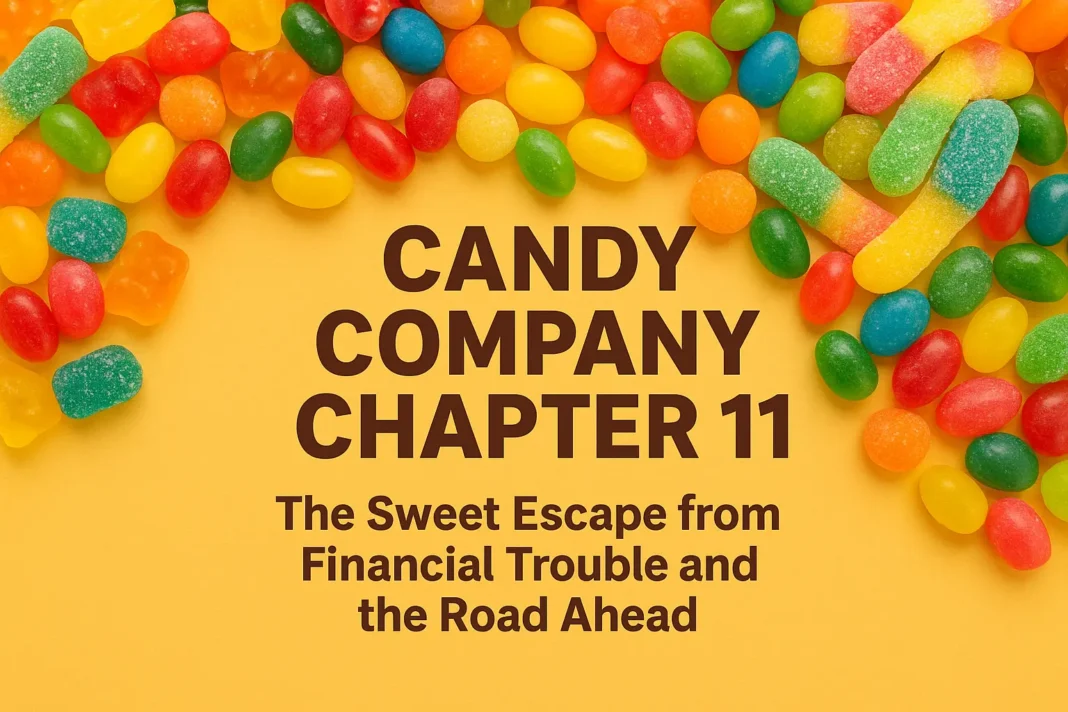A Sticky Situation for the Candy Industry

The candy company chapter 11 filing in October 2025 sent shockwaves through the online confectionery world. Once a beloved destination for everything from nostalgic sweets to party candy, the company is now battling mounting debts, rising costs, and fierce online competition.
But this story isn’t just about one company—it’s a reflection of the changing tides in the digital retail landscape.
A Look Back at the Candy Company’s Sweet Success
From Small Distributor to Industry Icon
For nearly five decades, this candy company built a reputation for delighting sweet lovers across the globe. What started as a small distribution business grew into one of the internet’s leading candy marketplaces.
How Online Candy Sales Became a Game Changer
When the digital era began, this candy retailer was ahead of its time. By selling bulk candy online, it became a favorite for party planners, businesses, and nostalgic candy fans.
Understanding Chapter 11 Bankruptcy
What Is Chapter 11 Bankruptcy?
When a company files for Chapter 11 bankruptcy, it doesn’t mean the doors close immediately. Instead, it’s a legal way to reorganize debts while keeping the business alive. Think of it as a “reset button” for struggling companies.
Chapter 11 vs. Chapter 7 — The Key Difference
Chapter 7 is liquidation—where everything gets sold off. Chapter 11, on the other hand, allows companies to restructure and try to recover. For this candy company, Chapter 11 offers a fighting chance.
Why the Candy Company Filed for Chapter 11
Declining Sales and Profit Margins
Revenue reportedly dropped by 10% to 20% in 2024, with projections showing a potential further decline of up to 50% in 2025. This decline became unsustainable for a company that relies heavily on seasonal demand.
Fierce Competition in the Online Candy Market
The candy company once had a niche corner of the internet. Today, that corner is overcrowded with massive competitors and direct-to-consumer startups.
Amazon, Direct-to-Consumer Brands, and Market Crowding
Amazon, Walmart, and new boutique candy brands have flooded the online market, offering fast shipping, lower prices, and endless choices.
Soaring Advertising and Shipping Costs
With online ad costs skyrocketing and global shipping expenses at record highs, maintaining profitability became a nearly impossible task.
The Changing Candy Market Landscape
Shifting Consumer Preferences
Consumers today want more than just sugar—they want healthier, sustainable, and guilt-free indulgence. The company’s traditional offerings couldn’t keep up with the shift.
The Rise of Health-Conscious Eating
Low-sugar, vegan, and organic candies are reshaping the market. This change left older candy retailers scrambling to adjust their product lines.
Inflation and Economic Pressures
High inflation has tightened household budgets, turning candy purchases into occasional luxuries rather than frequent treats.
Inside the Candy Company Chapter 11 Strategy
Goals of the Reorganization Plan
The main objective is to stabilize finances while continuing operations. Chapter 11 gives breathing room to strategize without the constant pressure of creditors.
Cutting Costs and Renegotiating Debts
The company is negotiating with suppliers and creditors to reduce payment obligations and delay due dates, improving cash flow.
Streamlining Operations and Supply Chains
By consolidating warehouses, automating logistics, and minimizing excess stock, the candy company aims to become leaner and more efficient.
Potential Investors or Buyers in the Mix
There’s talk that potential buyers or investors could step in. Merging with a modern candy startup or selling partial ownership could inject much-needed capital.
Impact on Employees and Customers
What Happens to Orders and Operations
Currently, the candy company remains operational. Customers can still order, but there may be temporary delays or stock shortages.
Maintaining Trust in Uncertain Times
Transparency will be key. Keeping communication open and ensuring order fulfillment will help maintain customer trust during this uncertain period.
Lessons from the Candy Company’s Struggles
Overreliance on E-Commerce Channels
Depending solely on online sales proved risky. Diversifying into retail partnerships, events, or subscription services could have reduced vulnerability.
Why Business Diversification Matters
A broader business model—combining physical stores, collaborations, and seasonal campaigns—could have cushioned the financial hit.
The Bigger Picture: What It Means for E-Commerce Retailers
Similar Struggles Across Online Businesses
The candy company chapter 11 filing is just one example of how challenging the digital market has become. Many online retailers face similar challenges—high costs and fierce competition.
How Other Companies Can Avoid the Same Fate
Adapting to consumer trends, investing in strong branding, and innovating product lines are essential survival strategies in 2025 and beyond.
The Path to Recovery
Could a Buyer or Investor Save the Brand?
There’s potential for revival if a major confectionery player or investor steps in. The brand’s legacy still holds strong emotional value for long-time customers.
Rebranding and Modernization Opportunities
By focusing on sustainability, innovative packaging, and nostalgic marketing, the company could reinvent itself for a new generation.
The Emotional Toll on Candy Fans
For many, this company isn’t just a store—it’s a part of their childhood memories. Watching it struggle feels like seeing a piece of the past fade away.
What Industry Experts Predict
Experts suggest this bankruptcy could spark consolidation in the online candy industry, leading to fewer but stronger competitors in the future.
Public Reaction and Social Media Buzz
Social media platforms are buzzing with reactions. Many users share memories of their favorite candies, while others express hope for a sweet comeback.
The Future of Candy Retail Post-2025
The candy industry isn’t crumbling—it’s transforming. Brands that blend nostalgia with health-conscious innovation will lead the next era of confectionery success.
Conclusion: Can the Candy Company Make a Sweet Comeback?
The candy company chapter 11 filing isn’t the end—it’s a new beginning. If the company uses this time to reorganize, modernize, and reconnect with its audience, a revival could be on the horizon.
Just like candy, sometimes life’s sweetest moments come after the bitter ones.
FAQs
1. What does the candy company chapter 11 filing mean?
It means the company is restructuring its debts and operations under court supervision, not shutting down immediately.
2. Can customers still buy from the candy company?
Yes, but expect some possible delivery delays during the reorganization process.
3. What caused the company’s financial troubles?
Falling revenue, intense competition, and high operating costs were major contributors.
4. Is the company planning to close stores?
Not at the moment. Operations continue while restructuring plans are developed.
5. Could the company make a comeback?
Yes—with rebranding, better strategy, and investor support, the company could bounce back stronger.







